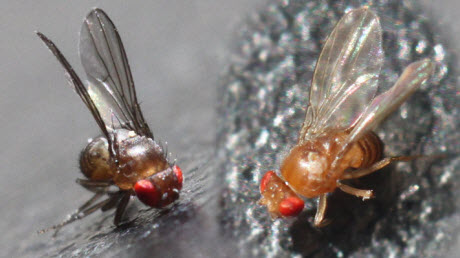When Sickness Leads to Greater Diversity
Research shows that when fruit flies get sick, their offspring become more diverse
 D. melanogaster. When infected, offspring of ebony rough (left) and wild type (right) fruit flies produce more genetically diverse progeny.Image credit: Dahlia Nielsen, NC StateNew research from North Carolina State University and Reed College shows that when fruit flies are attacked by parasites or bacteria they respond by producing offspring with greater genetic variability. This extra genetic variability may give the offspring an increased chance of survival when faced with the same pathogens. These findings demonstrate that parents may purposefully alter the genotypes of their offspring.
D. melanogaster. When infected, offspring of ebony rough (left) and wild type (right) fruit flies produce more genetically diverse progeny.Image credit: Dahlia Nielsen, NC StateNew research from North Carolina State University and Reed College shows that when fruit flies are attacked by parasites or bacteria they respond by producing offspring with greater genetic variability. This extra genetic variability may give the offspring an increased chance of survival when faced with the same pathogens. These findings demonstrate that parents may purposefully alter the genotypes of their offspring.
Fruit flies’ reproductive cells are usually haploid, meaning that there is only one copy of each chromosome in the cell’s nucleus instead of two. During meiosis, the form of cell division that creates eggs in females and sperm in males, female fruit flies produce eggs that contain only one set of chromosomes – each chromosome in the set may be a copy of the mother’s chromosome or a copy of the father’s chromosome. Or they may be a mixture of both chromosomes due to a process known as recombination. Under normal conditions each offspring of a female fruit fly has a 25 percent chance of getting a maternal copy of a chromosome, a 25 percent chance of receiving a paternal copy, and a 50 percent chance of receiving a recombinant chromosome.
In theory, under conditions in which organisms face new threats, such as those posed by parasites or pathogens, it could be advantageous to have offspring with more recombinant chromosomes. These offspring would have more novel combinations of alleles (versions of particular genes), increasing the chances that at least some of them would be well adapted to these threats.
Nadia Singh, an assistant professor of biological sciences at NC State, and her colleague and co-author of a paper describing the work, Todd Schlenke of Reed College, wanted to see if fruit flies have evolved such a strategy for coping with infections by bacteria or parasitic wasps. Singh and Schlenke exposed fruit flies to two different pathogenic bacteria, as well as to the parasitic wasp Leptopilina clavipes, which lays its eggs inside fruit fly larvae and devours the fly from the inside out unless it is killed by the fly immune system.
The findings, which appear in Science, were surprising. Females who survived bacteria or wasp infection produced a much greater proportion of recombinant offspring than control, uninfected flies. The surviving mothers made their offspring more diverse.
“We believe that this is an example of what has been called transmission distortion. In this case, something is signaling these female fruit flies to produce a higher proportion of offspring with recombined chromosomes than they would normally,” says Singh. “The result is that they’re hedging their bets, genetically speaking – creating a large number of very different offspring means that at least some of those offspring may be genetically better suited to surviving future threats from these bacteria or parasites.”
Even more interesting was the discovery that this signal may somehow be transmitted even when the female is exposed to the threat in the larval stage – well before egg production (and the associated chromosomal recombination) begins.
“It is interesting that stresses occurring early in development can influence a host’s reproductive machinery later in life – we don’t know yet what the infection signal is or how it is maintained across metamorphosis” says Schlenke. “And there’s no reason to think that this type of reproductive response to infection is unique to flies,” adds Singh. “We want to know whether other species do this, because it represents a novel way that parents can influence the potential fitness of their offspring.”
The research was supported by funding from NC State and by the National Science Foundation (grant 1257469 to Todd Schlenke). Graduate student Erin Keebaugh, postdoc Kathryn Kohl, and undergraduate students Dallas Criscoe (NC State) and Shelly Skolfield (Reed College) also contributed to the work.
